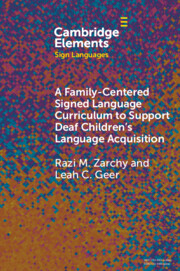Element contents
A Family-Centered Signed Language Curriculum to Support Deaf Children's Language Acquisition
Published online by Cambridge University Press: 02 August 2023
Summary
Keywords
Information
- Type
- Element
- Information
- Series: Elements in Sign LanguagesOnline ISBN: 9781009380720Publisher: Cambridge University PressPrint publication: 24 August 2023
